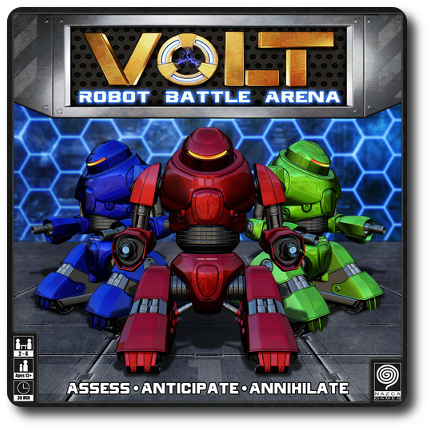
The Basics:
- For ages 6 and up (publisher suggests 13+)
- For 2 to 4 players
- Variable game play length
Geek Skills:
- Counting & Math
- Logical & Critical Decision Making
- Strategy & Tactics
- Risk vs. Reward
- Visuospatial Skills
- Cooperative & Team Play
Learning Curve:
- Child – Easy
- Adult – Easy
Theme & Narrative:
- Guide your robot in the arena to battle other robots TO THE DEATH (no, not really)
Endorsements:
- Gamer Geek approved!
- Parent Geek approved!
- Child Geek approved!
Overview
When you think of sports, I wouldn’t be surprised if baseball, basketball, football, and other team games come to mind. We often think of “sports” as being a physical human activity, but this is not always the case. In 1998, a television show titled “Robot Wars” hit the British airwaves and challenged how we look at sports. Now it was machines being powered by human ingenuity that battled in the area. In this game, you get a chance to test your own mental skills, logical thinking, strategic foresight, and tactical guile to become the ultimate robot battling champion.
VOLT: Robot Battle Arena, designed by Emerson Matsuuchi and published by Nazca Games, is comprised of 2 double-sided Arena game boards, 4 Player boards, 4 Player HUD screens, 4 Robot miniatures (in 4 different colors), 4 red standard six-sided dice, 4 white standard six-sided dice, 4 blue standard six-sided dice, 1 Control Point die, 4 Sequence tokens, 8 Damage tokens, 19 Victory tokens, 16 Module tiles, 16 Mine tokens, 4 Grenade tokens, 4 Magnetic Field tokens, 4 Teleporter tokens, 4 Tractor Beam tokens, and 4 Reflector tokens. All the components are durable and well made. The Robot miniatures, while all the same looking (except in color), are detailed and solid. Excellent quality game.
Game Set Up
To set up the game, first select the Arena game board that will be used. Place the selected Arena game board in the middle of the playing area. Place the other Arena game boards back in the game box.
Second, each player should take 1 Player board, 1 red, 1 blue, and 1 white six-sided die. They should also take 1 Player HUD screen and the Robot miniatures that matches the Player HUD screen color. Players should place their Player HUD screens so they are parallel to one of the 4 edges of the Arena game board. The Player board and dice go behind the player’s Player HUD screen.
Third, place the Control Point die, Sequence, Victory Point, and Damage tokens to one side of the game playing area.
Fourth, have each player place their Robot miniature on any space (except pits) that is along the edge of the Arena game board closest to them.
Fifth, roll the Control Point die and set the rolled value to one side of the game playing area where all the players can see it. Any other pieces still in the box should remain in the box until called for. See “Game Variants” for more information.
When completed, your game might look something like the following.
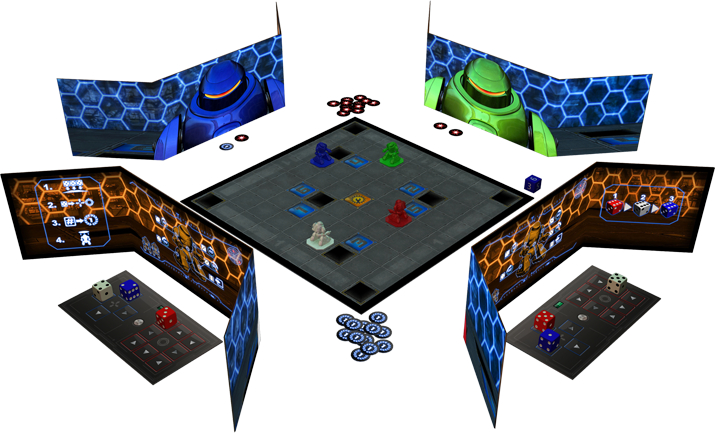
That’s it for game set up. Time to see which robot is the best fighter!
Robot Rumble
VOLT is played in rounds with no set number of rounds per game. A typical game round is summarized here.
Step 1: Place Dice
Each player sets their Player HUD screen in front of their Player Board. The goal here is to hide the Player Board from opponents. Using the dice, each player will “program” their robot for the round. There are two actions a robot can take: move and attack. Commands are programmed by using the six-sided dice, but the dice are NOT rolled. Players will select a number value and place it face-up on the Player Board. Lowest numbers always go first.
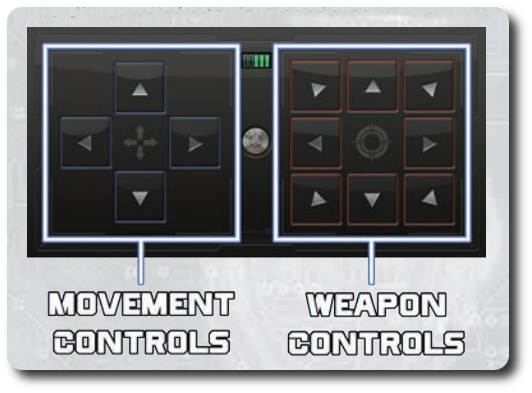
Movement is always up, down, left, and right from the perspective of the player’s sitting position. This is important. One player’s left is NOT the same as another player’s left in the game. It should also be noted that the robot miniature’s facing position DOES NOT MATTER in this game. Unlike other miniature games, players will not be spending time pivoting their robot. All of this is done automatically through the programmed commands. The number on the die determines the number of spaces the robot will move in the direction the die was placed on the Player Board movement control section. Again, direction is based on the player’s sitting position relative to the Arena game board.
Attacking is done in the same way, except the direction a robot can fire is both adjacent and diagonal. The number value not only determines the order in which the robots fire, but the strength of the attack. A stronger attack, which is represented by a larger number, will go later in the round. This leaves the robot open to attacks, but it also means the robot’s attack on other opponents will be more powerful and do more damage.
Note: Players cannot “stack” their dice on the Player Board. Each movement and attack direction can only be used once per round.
Step 2:Reveal and Resolve
Once all the players have placed their dice and programmed their commands, the Player HUDs are lifted. Movement and attacks are resolved for all players at the same time in the following order.
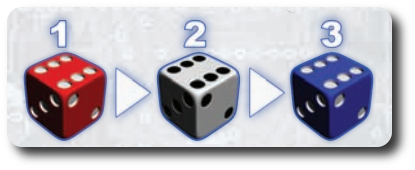
- First red dice, then white dice, and then blue dice, starting with the lowest number
- If two or more dice of the same color have the same value, movement goes first and then attacks
- If two ore more dice of the same color with the same value are on the same Player Board sections, each player adds the numbers of all three of their dice – the lowest number goes first
- If two or more dice of the same color are still tied, then each player randomly draws a Sequence token – the lowest number goes first
When resolving movement, the robot moves in a straight line in the direction indicated on the movement controls. The number of spaces moved is determined by the number on the die. Any and all robots that are on the same path are pushed. In this way, one robot could push one or more other robots. A robot must move its total number of spaces unless it hits a wall. In which case, the robot will just stop. It will not stop for pits or other hazards in the arena.
When resolving an attack, the weapon fires in a straight line in the direction indicated on the weapon controls. The number on the die determines the attack strength. An attack hits the first robot in the path and ends. Attacks go over pits, but are stopped by walls. If the attack is strong enough, it will force an opponent to shift the dice location (not the values) that are on their Player Board! When a robot gets hit, the owning player collects 1 Damage token. If the player collects 3 or more Damage tokens, their robot is destroyed and removed for the round.
Note: After resolving the action, remove the die from the Player board, but DO NOT change its value. Dice values are used to break ties.
Step 3: Score Victory Points
If a player destroys an opponent’s robot during the round (by using a weapon or pushing the opponent’s robot into a pit), they collect 1 Victory Point token. If the player’s robot is controlling (i.e. “on top of”) a Control Point space, they receive 1 Victory Point token.
Step 4: Respawn
If any player’s robot was destroyed during the round, they now return the robot to the game by placing it on any open space directly in front of them in the closest row on the Arena game board. A new round now begins with players hiding their Player board and starting again with step 1.
Pits, Control Points, and Repair Centers
Depending on the Arena game board selected, the players will have one or more special spots they will want to avoid and fight over.
Pits will send a player’s robot to their doom and remove them for the round. If a player’s robot is pushed into a pit, the opponent who pushed them will score a victory point, but the player’s robot will respawn with full health. If the player’s own commands send their robot into a pit, no victory points are awarded. However, the player must remove their robot for the duration of the round and will respawn with any damage it had prior to falling into the pit.
Repair Centers can be used by the players to remove 1 Damage token. Each time the robot moves over or stops on the Repair Center space, 1 Damage token is removed.
Control Points have a number. The Control Point die value determines which Control Point space will award a victory point at the end of the round. Any player who has their Robot stopped on the Control Point space at the end of the round that matches the number value on the Control Point die will receive 1 Victory Point token. If a player does win a victory point in this manner, the Control Die is rolled during step 1 of the new round to randomly determine the new Control Point.
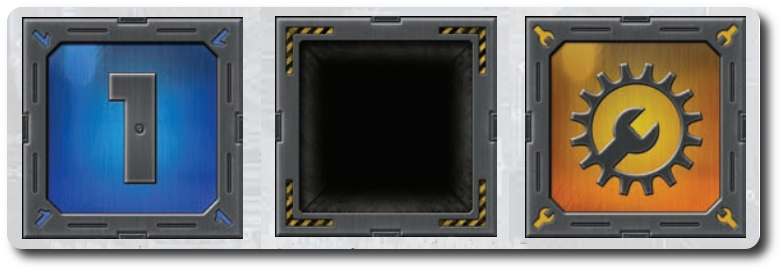
From left to right: Control Point, Pit, and Repair Center
Victory
The game continues until 1 player has collected 5 or more Victory Point tokens at the end of the round.
Game Variants
VOLT comes with a number of game variants. Here are just a few.
Advanced Game
The game play described above is considered the “basic game”. The Advanced game uses the same rules, but includes Module tiles. Modules tiles introduce new weapons and equipment that are available to all the players. Some examples of Modules include the Twin Blasters that do more damage, Gravity Treads that limit how far a robot can be pushed, and an Explosive Core that causes a damaged robot to explode and possibly destroy an opponent’s robot, too!

Draft Match
This game variant allows players to select which Module tiles they will equip their robot with. Unlike the Advanced Game, the Module tiles the players select belong only to them. When a player wins a game, they flip one of their Module tiles over. This Module tile is no longer available. A new game begins with each player selecting which Module tile they will equip. The first player to win 2 games wins the match.
Team Play
This game variant can use the basic or advanced game play. Players group into teams of 2 and attempt to be the first team to collect 10 victory points. If one team member accidentally destroys another team member, the opposite team scores a victory point.
House Rule
Two Player Game
Playing VOLT with only 2 players doesn’t allow for much robot interaction. The Arena board is surprisingly large when only 2 robots occupy it. Large and empty. To alleviate the inherent boredom that comes from too wide a space for too few players, we gave each player 2 robots. Game set up and play is the same, except a player must manage 2 robots instead of just 1. This creates some very interesting game play, since a player can organize their robots to cooperatively take down an opponent or use one to guard the other while it races to the Control Point.
Short or Long Game
You can easily adjust the game length by changing the required number of victory points to win. This allows players to play a quick game of VOLT or a longer game. I think 5 victory points, per the game rules, is perfect length of time to play the game, but sometimes “time” is not on your side. Luckily, VOLT is.
Thunderdome
Instead of using the Control Point die to randomly determine where a victory point can be earned, use it during game set up to randomly place Module tiles. These Module tiles can be picked up during the game and “equipped” by the players IF they end their movement on the Module tile. The Module tile only provides the bonus to the player who equips it. When a player’s robot is destroyed, any Module tiles it had are removed from the game. The first player to earn the predetermined victory points wins.
To learn more about VOLT: Robot Battle Arena, visit the game’s web page.
Prediction
The only other robot battle game I have is RoboRally. Players have to “program” their robots using cards and then flip them over one at a time. There are game board elements that affect game play and cause chaos. For example, giant presses that squash robots or conveyor belts that drop robots into bottomless pits. The game can be confusing and maddeningly frustrating, but it’s also a game that requires a lot of strategy and tactics. Which is why it continues to be played and enjoyed by the Gamer Geek crowd. Not so much the Parent and Child Geeks, however.
VOLT has many of the same elements as RoboRally, but feels more streamlined and a lot less chaotic. The “programming” aspect appears to be very intuitive, the movement is straightforward, and combat is as simple as point and fire. My concern is that the game will be seen as a bit too simplistic by the Gamer Geeks, but I do think the Parent and Child Geeks are really going to like VOLT.
Teaching VOLT is best done by example. Take a Player board and demonstrate how the dice are used to determine order of play, distance traveled, and attack power. I do not recommend using the Module tiles for the first game. There will be enough going on for new and inexperienced players wrestle with. However, if you are playing with individuals who are familiar with games, especially miniature games, do include the Module tiles from the very start. Note that this game doesn’t require any reading and very little math. This opens the game to younger Child Geeks.
And so, after teaching the game to my two oldest little geeks, I asked them their thoughts on VOLT so far.
“I really like this! Sounds a lot simpler than RoboRally, but faster, too.” ~ Liam (age 9)
“Let’s play with the grenades and mines, Dad!” ~ Nyhus (age 6)
The game does appear to be faster and simpler. I hope that doesn’t reduce the strategy and tactical play. Let’s power-on our robots and roll into the arena. Time to put this game to the test.
Final Word
It took every Child Geek who played the game, our youngest at age 6, a few rounds to get the hang of programming their robot. After that, they were super stars. How you play the game was a bit less intuitive than I originally thought, but the difficulty curve is still low enough to allow players to easily learn how to play during the game without being put at a serious disadvantage. Every Child Geek we played with demonstrated an excellent understanding of strategy and tactics. My 6-year-old even baited me a few times. You should have heard him laugh when he pushed me and another player into a pit when resolving movement. According to one Child Geek, “This is a really fun game. I like all the different weapons you can use.” Another Child Geek said, “The best part about this game is blowing up your parents!” And finally, one very happy Child Geek said, “This reminds me of FRAG, but I think I like this better. It’s faster.” All the Child Geeks voted to approved VOLT.
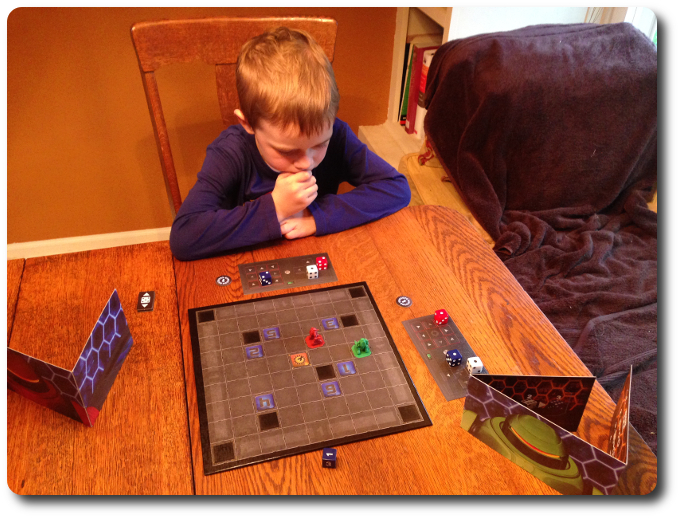
My 6-year-old pauses for a moment to reflect on his programming decisions
The Parent Geeks were very pleased with VOLT, finding it to be an entertaining and engaging family game. They liked how easy it was to program their robots and how much fun it was to see how everything played out in the arena when the Player boards were revealed. According to one Parent Geek, “I really like how you can plan all you want, but in the end, what you need to really consider is how the other players will move their robots.” Another Parent Geek said, “I found this game easy to understand, fun to play, and enjoyable from start to finish. I only wish it could play up to 6 players.” All the Parent Geeks voted to approve VOLT.
The Gamer Geeks either found the game to be “OK” or “really good”. A number of the Gamer Geeks who played VOLT were RoboRally veterans. They couldn’t help but compare the two games at first. A number of assumptions were made and VOLT was classified as a “simpler version of RoboRally“. After a few games, that classification changed. According to one Gamer Geek, “I think the game is OK. Not sure if it’s a Gamer Geek’s game, but it’s an excellent family game and I would play it.” Another Gamer Geek said, “This is an outstanding game and so much better than RoboRally. It’s rich with strategy and tactical game play. Simply excellent.” And finally, another Gamer Geek said, “This is the kind of game I’ve been looking for. It’s light, easy to set up, and will entertain me for hours.” When all the votes were counted, VOLT won the Gamer Geek approval.
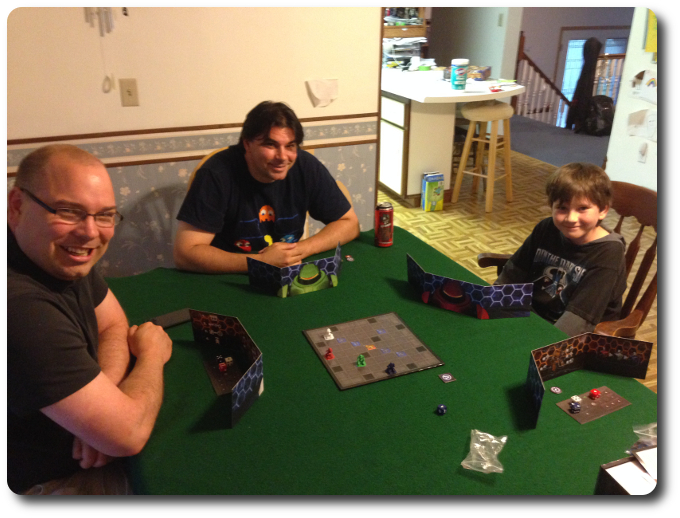
Two Gamer Geek generations battling it out on the family gaming table (!!awesome!!)
I found VOLT to be a lot of fun. It plays very well with mixed groups and has a lot of different game variants to use. The 16 Module tiles are fun to mix and match and the game rules are flexible enough to allow players to create their own game and rule variants. For example, my little geeks and I created 3 new Module tiles. Feel free to add these to your game, if you like.
- Grease Gun: On a hit of 1, the targeted robot suffers no damage but must now move 1 extra space after they finish their movement. Remove grease by rolling over or stopping on Repair Center.
- Scramble Beam: On a hit of 6, the targeted robot must randomly roll one of their 3 dice still on their Player board. Dice location does not change. Regardless of number rolled, the targeted player will go last for the die color that was rolled.
- Anti-Gravity Treads: Robot can move through pits, but cannot stop on them.
I feel the game is lacking a few things. First, it could use more Arena boards. It comes with 2 that are double-sided, but after playing the game 20 or so times, the Arena boards are no longer interesting. Second, I would have preferred to have seen the game come with 6 robots instead of just 4. My family has 5 individuals, which means someone is always left on the sidelines. Most gatherings includes more than 4 individuals, too. With 6 robots, you could play with 3 teams of 2 or 2 teams of 3! Admittedly my complaints are exceedingly trivial. I’d even go so far as to say “petty”. Heck, I could upgrade my own game by making the components if I really wanted to, but there is no real need. I have yet to have a bad experience with the game as it is.
VOLT provides Gamer Geeks with a game that requires strategy and tactics to win, but is accessible enough to allow their children and non-gamers to join in on the fun. Miniature game purest will be disappointed with VOLT. Much of the traditional miniature movement and combat rules have been either removed or simplified to allow for quick game play. Decision making has also been simplified, but is still very important. Players must think carefully how they want their robot to move, consider where their opponents might move, and determine how important timing is. That’s still a lot to consider and makes each round feel very important, but the weight of the each decision is not crushing.
If you play this game, I suggest you play it with 4 individuals. Playing with 3 is fine, but it feels unbalanced when 2 players go after 1 unlucky player. With only 2 players, the game feels slightly uninteresting since robots can easily avoid each other. I suggest you use our House Rule if only playing with 2 players. With all 4 robots in the arena, you have yourself a really good time. Do sit down and play VOLT: Robot Battle Arena when the opportunity presents itself. Good clean robot carnage fun for everyone!
This game was given to Father Geek as a review copy. Father Geek was not paid, bribed, wined, dined, or threatened in vain hopes of influencing this review. Such is the statuesque and legendary integrity of Father Geek.




Pingback: In Review: Father Geek’s Monthly Newsletter (June 2014) - Father Geek
Pingback: In Review: Father Geek’s Monthly Newsletter (July 2014) - Father Geek
Here’s a couple of corrections. When reentering your robot you may place in on any side of the board. To remove damage with the center repair tile, you must actually land on the tile. Passing over it does nothing for you. That’s all I can think of for right now, but I really did enjoy your review to this great game.
Thank you, Arthur, for taking the time to read my review and providing helpful information that will allow us to enjoy VOLT even more than we already do!
Pingback: Mech Deck Game Review (prepublished version) - Father Geek